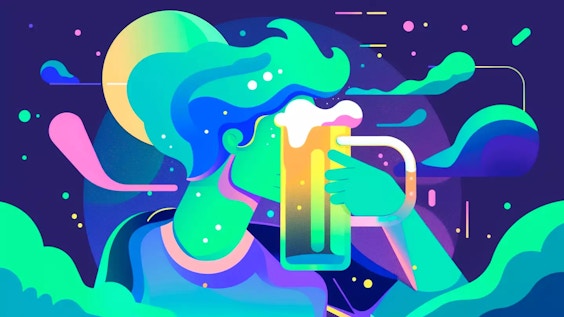I Am Sober is a free app that helps you get some control back in your life.

Understanding the Five Types of Alcoholism
Last Updated: Fri, March 29, 2024If you believe you have a problem with alcohol, you may not realize that there are different types of alcoholism. Many people see this as an umbrella term, but five different categories of alcoholism have been identified, helping us to better understand this addiction. These types have been categorized by the cause, the behavior, the likelihood, and the history of people who become alcoholics.
Keep reading to find out about the five types of alcoholism and the kinds of drinking behaviors that could indicate an alcohol problem.
1. Chronic Severe Alcoholic
One category of alcoholism that fits the definition most people think of is chronic severe alcoholism. This is often used to describe middle-aged men who started drinking at a young age and drink to function in everyday life. A chronic severe alcoholic may also struggle with criminal behavior, have addiction-related health issues, or struggle to hold down a job.
Chronic severe alcoholics usually have a family history of alcoholism, which explains why they began drinking at such a young age. Co-occurring mental health disorders are also very common and range from antisocial personality disorder to depression to anxiety disorders.
Because of their addictive tendencies, chronic severe alcoholics also have a strong likelihood of abusing other addictive substances. This includes things like marijuana, cigarettes, cocaine, and opioids.
2. Functional Alcoholic
As the name suggests, functional alcoholics are people who have a drinking problem but still manage to function in everyday life with minimal interruption. They often have alcoholic behaviors but can still suppress them enough that their life remains relatively unchanged. Because of this, functional alcoholics usually feel safe at the moment and may not be able to admit to themselves that they have an addiction.
Functional alcoholics Will usually keep their drinking to specific days of the week or certain times every day. For instance, they can still hold down a job and maintain normal relationships but drink to excess when they do drink. They may drink until they are blackout drunk every night, or they may be unable to stop drinking at bars or parties.
Due to the nature of a functional alcoholic, it can be challenging to figure out if this is something you may be struggling with. Some signs of functional alcoholism include:
-
Drinking instead of eating
-
Getting blackout drunk
-
Craving alcohol
-
Hiding alcohol
-
Only doing things that involve alcohol
3. Young Adult Alcoholic
A dangerously large subtype of alcoholics is young adult alcoholics. These are people who are between 20 and 24 years old and are currently battling alcohol addiction. In comparison to other types of alcoholics, they may not drink as much alcohol, but when they do drink, they do so in a binge pattern.
Binge drinking is a common form of alcohol consumption in America and is often overlooked and brushed under the rug. It usually involves someone drinking five or more alcoholic beverages in one sitting. This can come with very dangerous health consequences, especially since most binge drinkers are between 18 and 24 years old.
Young adult alcoholics do not usually have a family history of addiction or related mental health disorders. They are also much less likely to seek treatment or even admit that they have a drinking problem. Young adult alcoholics also have a higher risk associated with their drinking due to alcohol poisoning, blackouts, and drinking in unsafe situations.
4. Young Antisocial Alcoholic
A category of alcoholics that is directly related to mental health is the young antisocial alcoholic category. This is used to describe individuals in their mid-20s who usually began struggling with alcohol addiction at an early age. About half of young antisocial alcoholics have a family history of alcoholism and abuse other addictive substances like cigarettes and marijuana. About half of young antisocial alcoholics also suffer from antisocial personality disorder, which is a common link between alcohol abuse and addiction. This can often be accredited to the impulsivity, disregard for rules, and lack of remorse that can often come with antisocial personality disorder.
5. Intermediate Familial Alcoholic
A more unique category of alcoholism that most people are unaware of is intermediate familial alcoholism. This is used to describe someone who began drinking when they were nearing adulthood and didn’t start to struggle with alcohol abuse until their mid-30s. A large percentage of intermediate familial alcoholics have a family history of alcoholism, have suffered from depression, and may also suffer from bipolar disorder.
There is a large percentage of intermediate familial alcoholics who smoke cigarettes and abuse substances like cocaine and marijuana. Despite the addictive tendencies intermediate familial alcoholics have, most are able to hold down a stable job and are married with families and other healthy relationships.
Different Types of Drinking Behaviors
Along with the different categories of alcoholism, there are also different types of drinking problems someone could be participating in. Recognizing these drinking problems can help you identify addictive behaviors before they get out of hand.
-
Social drinking: A prevalent type of drinking across the world is social drinking in different settings with friends, coworkers, or family. It isn’t always a serious problem, but it can quickly escalate.
-
Thrill-seeking: Some people have a tendency to drink because they are risk takers and want to enjoy the effects of being drunk. They may drink to excess at bars, parties, or concerts and may showcase aggressive, impulsive, and other dangerous tendencies when drunk.
-
Coping: Some people do not drink for fun but rather drink as a way of dealing with emotions like stress and anxiety. This can easily start to get out of hand as they may start to rely on alcohol to suppress unpleasant emotions, requiring more and more alcohol to get the desired results.
Conclusion
If you or a loved one struggles with addictive behaviors, you will want to understand the different types of alcoholism. This can help you better understand if there is an actual problem and how to best address it.
Keep in mind that not everybody is going to fit perfectly into one of these categories, as addiction is a very personal thing. Never be afraid to reach out and ask for help if you believe your drinking is escalating or has become a long-term problem that is negatively impacting your life.
I Am Sober is a free app that helps you get some control back in your life.





